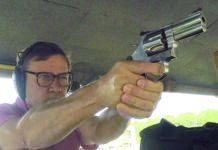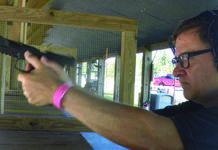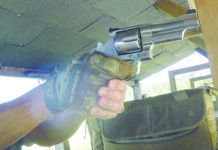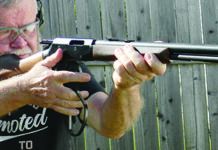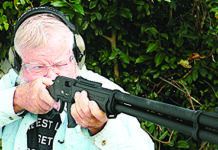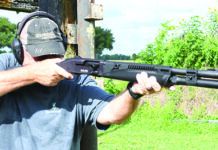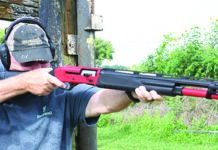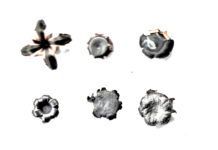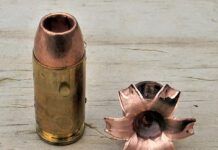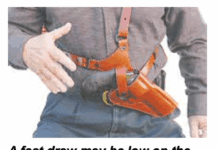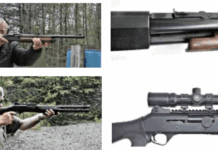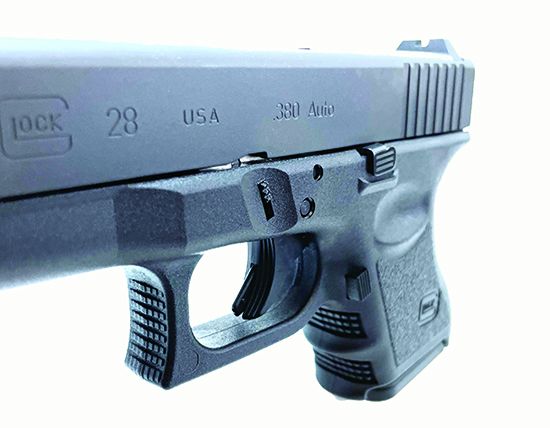The typical 380 Auto pistol has evolved from compact guns like the Walther PPK/S and Beretta 84 to subcompact pistols like the Glock G42 and Ruger LCP. A few manufacturers, such as Kimber, SIG, and Springfield Armory, shrunk their 1911 designs, too, and retrofitted these guns in 380 Auto. With most of these guns there is a compromise. If you wanted a more compact concealed-carry gun, the trade-off is a harder-to-operate and tougher-to-shoot pistol with limited-capacity single-stack magazines.
However, there are some higher-capacity 380s out there, so we wanted to take a look at a trio of double-stack 380 Auto pistols with larger ammo payloads. The three handguns in this match-up are the re-introduced Glock G28, a Bersa Thunder 380 variant named the Combat Plus, and a Beretta Model 86 knock-off, the Girsan MC 14T imported by EAA.
All three of these pistols use simple blow-back operating systems, feed off double-stack magazines, have open sights, are compact in size, and are chambered for 380 Auto (also called 380 ACP for Automatic Colt Pistol) ammunition.
How We Tested
We tested this trio of 380s from 15 yards and used a rest to gather accuracy. For defense-shooting drills, we set USPSA targets at 7 yards and shot Mozambique Drills. This drill is also called the Failure Drill for those who are politically correct. From a low hold, fire two shots to center of mass as fast as possible then place a third shot in the A-zone of the head outlined on the target. We fired Hornady Critical Defense rounds loaded with 90-grain FTX Flex Tip eXpanding bullets, and TulAmmo and MagTech ammo, both loaded with 95-grain full metal jackets.
Our top-line summary is this: All the guns performed flawlessly after extensive shooting; however, there was a choice to be made. Choose an oversized gun, a traditional design, or a gun with unique capabilities? The Glock G28 is oversized for a 380 Auto. Why get a G28 when you can get a G26 in 9mm for the same size and same round count? The Bersa is a traditional DA/SA metal-frame pistol design that is nothing remarkable, but is very well suited as a concealed-carry gun. The Girsan, with its tip-up barrel design, is easy to operate, especially for those shooters with compromised hand strength. Following are more details.
Glock G28 380 Auto,
$515
Gun Tests grade: B+
The G28 is the same size as a Glock G26 in 9mm, so it has bulk without the power. There’s nothing innovative about this Gen3 Glock, but it is reliable. Recoil was soft, and the pistol was accurate.
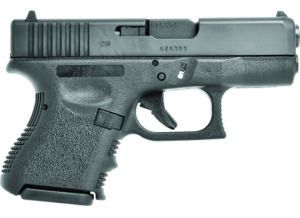
| Action Type | Semi-auto, blow back |
|---|---|
| Trigger | Striker fire |
| Overall Length | 6.5 in. |
| Overall Height | 4.1 in. |
| Maximum Width | 1.2 in. |
| Weight Unloaded | 20.6 oz. |
| Weight Loaded | 24.1 oz. |
| Barrel | 3.4 in. |
| Capacity (Double Stack, Flush Fit) | 10+1 |
| Slide | Black steel |
| Slide Retraction Effort | 15.0 lbs. |
| Frame | Black polymer |
| Frame Front Strap Height | 1.4 in. |
| Frame Back Strap Height | 2.4 in. |
| Grip | Textured polymer |
| Grip Thickness (Maximum) | 1.2 in. |
| Grip Circumference (Maximum) | 6.0 in. |
| Front Sight | White dot on post |
| Rear Sight | Outlined notch |
| Trigger Pull Weight | 6.5 lbs. |
| Trigger Span | 2.8 lbs. |
| Magazines | 2; polymer body; 10-rnd. |
| Safety | Trigger lever |
| Warranty | Limited lifetime |
| Telephone | (770) 432-1202 |
| Website | US.Glock.com |
| Made In | U.S. |
The Glock G28 was first introduced in 1998 but was only sold to law enforcement. In 2023, TALO introduced a limited run of G28 pistols to the commercial market. TALO also “re-introduced” a G25, which is a G19 chambered in 380 Auto. Our first question is, why would you want a G28 in 380 Auto when the G26 in 9mm is the same size and offers more firepower? The obvious answer is less felt recoil. The G28, with its polymer frame, has minimal recoil. This is a comfortable pistol to shoot, even with the small grip.
Handling the G28 is like a step back in time because the G28 hasn’t progressed past Glock’s 3rd Generation of guns. In other chamberings, Glock is currently in its 5th Generation of guns. The Gen3 has textured grip sides, a serrated back strap, and finger grooves on the front grip strap. Some Glock devotees claim the Gen3 guns have the best frames.
What’s different about this Gen3 Glock compared to all other centerfire Glocks, is the G28 (and G25) use a blowback action. All other centerfire Glocks use a locked-breech tilting-barrel system. What’s interesting is the G42, which is also chambered in 380 Auto, uses a locked breech, tilting barrel system, not a blowback system.
Another difference is the magazine. Because the 380 Auto cartridge is shorter than a 9mm cartridge (but the bullets are the same diameter), the G28’s magazine is retrofitted to accept 380 rounds yet has the same outside dimensions as the 9mm G26 magazine. The witness hole side of the G28 magazine is ridged, giving a tactile and visual clue that this magazine is not a 9mm magazine.
The small but fat grip of the G28 fills your hand but has no shelf for your small finger. Curling your small finger under the flush-fit magazine is a good technique to shoot this pistol. The Gen3 trigger is mushy and had a pull weight of 6.5 pounds. On the bright side, the trigger is consistent. Our best five-shot group was with TulAmmo’s 95-grain FMJ bullet. It measured 1.41 inches for the smallest group and averaged 1.68 inches. The MagTech with the 95-grain FMJ had a best group that measured 1.99 inches and an average of 2.04 inches. The Hornady Critical Defense load with a 90-grain FTX hollow point had a best group of 2.72 inches and averaged 3.64 inches. Overall, the accuracy was good for a subcompact pistol.
The small grip makes the pistol difficult to shoot accurately at distances like 15 yards. At close targets, it is easy to land all shots in the A-zone of a USPSA target at 7 yards. The A-zone center of mass on the USPSA measures 11.5 inches high by 5.9 inches wide. The top A-zone measures 1.9 inches wide by 5.9 inches high. Head shots need to be surgical, and the G28 allows you to make the shot with ease, as long as you can handle the mushy and heavy trigger. Gen5 Glock triggers are much better, and Glock should consider fitting the G28 with one of them.
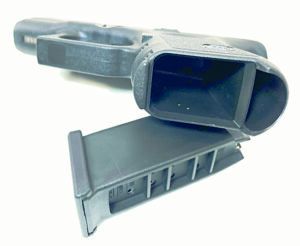
Magazines — two are included with the pistol in a hard case — are easy load up to and through the tenth round. Sight are just okay. We like the front white dot and the outlined notch rear for the contrast, but a brighter front sight would be better. Recoil was very tolerable due to the wide grip and polymer frame. There is some muzzle flip, as there is with all subcompact pistols. It took about 15 pounds of effort to retract the slide, but because the slide was so wide, it provided an adequate grasp.
The tapered magazine makes reloading easy and fast, but seating the magazine can be a challenge for users with large hands. A technique is to place your fingers on the slide and thumb under the floor plate and squeeze the magazine to seat it. Since your hand overlaps the small grip, you can’t slap the magazine home. Otherwise, we had no issues. The G28 ran flawlessly.
Our Team Said: The G28 offers less recoil than the G26-chambered 9mm, and for that fact, it might make a good training/transition gun. We thought the pistol was too big. If recoil is an issue, we’d pack a G26 and shoot lower-velocity rounds in it before we’d pack a G28. If you are a Glock fan, the G28 might be your choice for a double-stack 380 Auto, but there are less costly options, in our opinion.
| 380 ACP RANGE DATA | |||
|---|---|---|---|
| Hornady Critical Def. 90-grain FTX | Bersa Thunder 380 Combat Plus | Glock G28 | EAA Girsan MC 14T |
| Average Velocity | 951 fps | 929 fps | 979 fps |
| Muzzle Energy | 180 ft.-lbs. | 172 ft.-lbs. | 191 ft.-lbs. |
| Smallest Group | 2.71 in. | 2.72 in. | 1.82 in. |
| Average Group | 2.73 in. | 3.64 in. | 2.35 in. |
| MagTech 95-grain FMJ | Bersa Thunder 380 Combat Plus | Glock G28 | EAA Girsan MC 14T |
| Average Velocity | 878 fps | 875 fps | 946 fps |
| Muzzle Energy | 162 ft.-lbs. | 161 ft.-lbs. | 189 ft.-lbs. |
| Smallest Group | 2.12 in. | 1.99 in. | 1.30 in. |
| Average Group | 2.34 in. | 2.04 in. | 1.51 in. |
| TulAmmo 95-grain FMJ | Bersa Thunder 380 Combat Plus | Glock G28 | EAA Girsan MC 14T |
| Average Velocity | 907 fps | 887 fps | 926 fps |
| Muzzle Energy | 166 ft.-lbs. | 159 ft.-lbs. | 181 ft.-lbs. |
| Smallest Group | 1.18 in. | 1.41 in. | 1.50 in. |
| Average Group | 1.24 in. | 1.68 in. | 1.71 in. |
To collect accuracy data from the bench, we fired five-shot groups at 15 yards using a rest. We used a Garmin Zero C1 Pro Chronograph to record velocities.
Written and photographed by Robert Sadowski, using evaluations from Gun Tests Team members. GT




